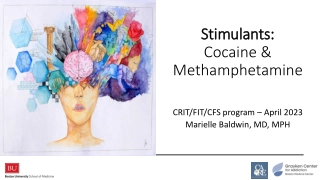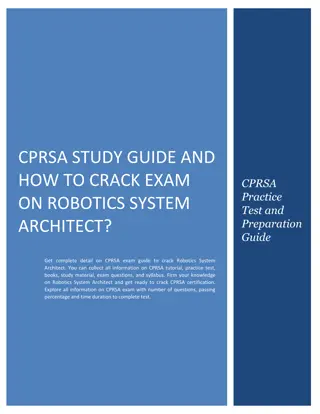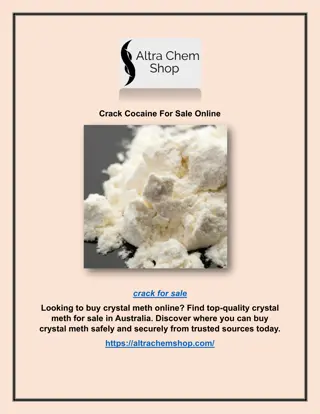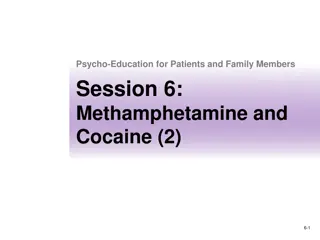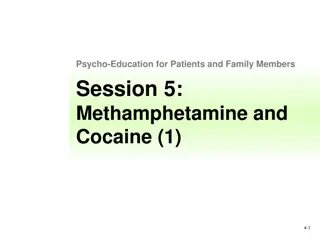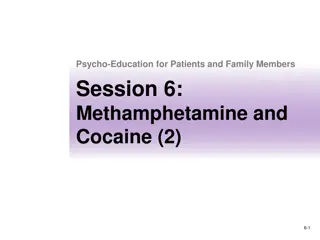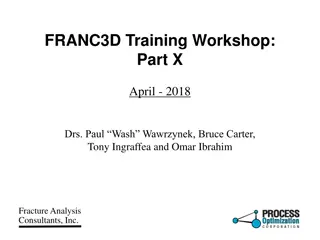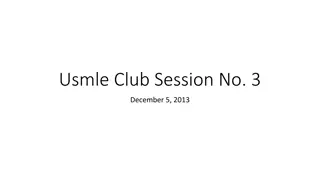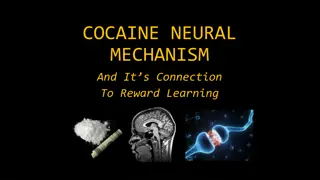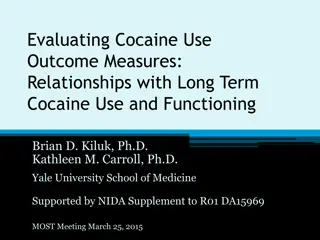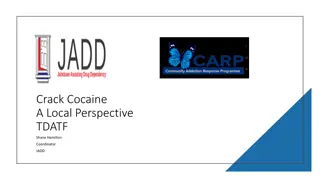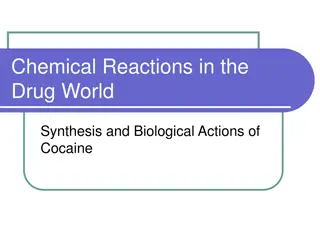Understanding Crack Cocaine: Effects, Risks, and Usage
Chemical altered cocaine powder that forms crystals or rocks, crack cocaine is a highly addictive stimulant drug that produces immediate highs but comes with severe health risks. It can be smoked or injected, leading to short-term effects like increased heart rate and paranoia, as well as long-term consequences such as cardiovascular damage and addiction.
Download Presentation

Please find below an Image/Link to download the presentation.
The content on the website is provided AS IS for your information and personal use only. It may not be sold, licensed, or shared on other websites without obtaining consent from the author. Download presentation by click this link. If you encounter any issues during the download, it is possible that the publisher has removed the file from their server.
E N D
Presentation Transcript
CRACK COCAINE WHAT IS IT?
WHAT DOES IT DO? Chemically altered cocaine powder that forms crystals or rocks that can then be heated to produce vapour that can be inhaled. Crack is a highly addictive stimulant drug. Makes people feel alert, energetic and confident. Crack is a more intense version of cocaine which gives an immediate high but wears off very quickly in approximately 15 minutes. Very high risk of dependency and health problems.
HOW IS IT TAKEN? Most commonly smoked in a pipe. Homemade pipes from bottles or tin cans is not recommended. *Services have access to appropriate pipes. Crack can also be dissolved in water and injected. When injected in conjunction with heroin, it is known as speedballing . Produces immediate, intense high. Quickly followed by a crash/comedown.
POSSIBLE SHORT-TERM EFFECTS Feeling energetic and confident. Sudden increase in heart rate and blood pressure. Raised body temperature. Restlessness. Hyperactivity. Dilated pupils. Dry mouth. Sweating.
SHORT-TERM EFFECTS CONTINUED Nausea. Loss of appetite. Increased sex drive. Paranoia and irritability. Crash/comedown with possible suicidal thoughts.
LONG-TERM EFFECTS Constriction of oxygen to blood vessels that interrupt blood flow to respiratory and gastrointestinal systems. Cardiovascular damage. Stroke. Insomnia, exhaustion and ability to relax. Marked changes in mood/behaviour. Loss of appetite. Feeling aggressive or becoming violent. Anxiety/depression with suicidal thoughts.
LONG-TERM EFFECTS CONTINUED Paranoia and hallucinations. Digestive disorders associated with reduced blood flow. Kidney and liver problems. Possible loss of sex drive if used long term. Injecting can lead to abscesses. Weight loss. Financial issues/drug-related debt. Dependence.
HEALTH RISKS Overdose as a result of high body temperature causing convulsions, heart attack or heart failure. It is possible to die from an overdose. This increases with amount taken and times consumed. Ammonia and rat poison are common compounds found in cocaine/crack cocaine. The inhalation of these compounds, particularly when using homemade pipes, can cause breathing difficulties, wheezing, coughing and other asthma-type symptoms and is often referred to as crack lung. Crack users are vulnerable to respiratory problems such as Tuberculosis (TB) and makes them susceptible to other associated diseases from weakened immunity, such as HIV.
HEALTH RISKS CONTINUED Those using crack may experience skin problems, such as itchiness, rashes, eczema, or experience a change in skin colour to a blue/grey colour. People often suffer burns to the mouth and thumbs. Cuts, sores and blisters on the mouth are common with crack use and what also lead to the spread of diseases due to sharing pipes. Extreme weight loss can occur in those using high amounts. It is possible for someone to go without eating for a number of days. There is a risk of blood-borne viruses in those who are using.
HEALTH RISKS CONTINUED Pregnancy involves normal cardiovascular changes which are exacerbated by the use of cocaine. Serious problems as a result can lead to high blood pressure and sudden miscarriage, pre-term labour and difficulties in labour. Cocaine reduced the amount of oxygen received by the baby which leads to lower birth rates, possible abnormalities or still birth. Mental health can pose particular challenges for some people taking cocaine. Using alcohol and cocaine together results in the creation of Cocaethylene in the body increasing the risk of damage to the liver and heart. Alcohol prolongs the effects of cocaine and it takes longer to leave the system than cocaine alone also meaning the person is unaware of their true intoxication level. Cocaethylene increases the risk of epilepsy, suicide, violence, accidents and sudden death,. In 2015, (the latest data) cocaine was recorded in 12 alcohol related deaths.
OVERDOSING Cocaine can raise the body s temperature which can cause convulsions, a heart attack or heart failure. Risk of overdose increases as more is consumed. Risk of overdose is increased if mixed with other drugs and alcohol. Overdose is more likely if cocaine is injected.
WHAT MIGHT AN OVERDOSE LOOK LIKE? Restlessness. Pressured speech. Change in behaviour. Body temperature increase feeling very warm and having hot skin. Flushed face. Muscle cramps. Stiffness in arms and legs. Confusion. Seizure.
WHAT MIGHT AN OVERDOSE LOOK LIKE CONTINUED Increased motor activity. High heart rate more than 100 beats a minute. Hypertension high blood pressure. Irregular heart rhythm. A heart attack. A stroke. Loss of consciousness.
FURTHER RISKS DRUG RELATED DEBT & INTIMIDATION Drug-related debt is acquired easily with cocaine because of its addictive nature and short-term effects, the expense of it can lead to serious dependence resulting in withdrawal symptoms such depression, fatigue, increased appetite and insomnia. The symptoms lead to increased use and dosing which can lead to high financial debts with suppliers. Drug-related debt results in drug-related intimidation and/or violence to the user and to their family/friends/partners/loved ones.
OTHER IMPORTANT INFORMATION TO KNOW There is a higher risk of bulking agents being present in crack cocaine than pure cocaine. Heavy cannabis use with high doses of THC can exacerbate the paranoia symptoms experienced by those who use crack cocaine. Crack cocaine is more addictive than cocaine and requires more consumption to remain high. It, therefore, has a risk of severe dependence as the brain changes to adapt to getting its dopamine from cocaine rather than naturally.
HARM REDUCTION Avoid using homemade pipes the high temperature required to burn the substance creates burn risks to mouth and face and risks of inhaling toxic fumes from homemade products as they are burning. Avoid sharing pipes to prevent blood borne viruses spreading. Avoid using Brillo pads as a gauze for pipes as when heated, can cause burns and lung damage. Start with a test dose first and try not to smoke the whole rock at once. Inhale slowly from a pipe and try not to hold the breath in your lungs. Take time between sessions. Allow the pipe to cool down and check how you are feeling. Look after your lips! Lips and mouths can get blisters and sores that are often unnoticed due to the anaesthetic compounds in cocaine.
MORE IMPORTANT INFORMATION Injecting crack has a high potential for overdose. Cocaine s anaesthetic compounds can numb the injection site making it difficult to penetrate a vain and increases the risk of damage. Ask services for more paraphernalia than you think you need in case you use more than intended. Always carry condoms. If it smells like ammonia, consider not using it. If you or a friend are feeling low following a crash/comedown, seek professional help and watch out for friends having suicidal thoughts.
IF YOU ARE WORRIED ABOUT SOMEONE AFTER THEY HAVE TAKEN CRACK COCAINE Don t take any more. Don t take any other drugs/alcohol/substances. If you know how, put the person in the recovery position. Call 999/112. Stay with the person. See services in your area. Services map: https://www.drugsandalcohol.ie/services_map tiglin.ie cris@mqi.ie livinglifecounselling.ie
SOURCES/REFERENCES HSE drugs.ie (n.d.) Crack cocaine. https://www.drugs.ie/drugtypes/drug/crack_cocaine[Accessed on 02/01/24] Images free to use and share commercially: Google.ie For more information follow the link below; HRB National Drugs Library (2024) Drugs and alcohol factsheets


